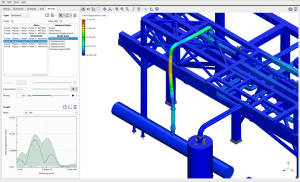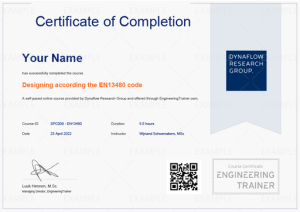
Performing Vibration Measurements: Pipe Stress Assessment
Training Courses Performing Vibration Measurements: Pipe Stress Assessment Free Course Preview Download Brochure About The Course This course teaches you all the fundamentals required for
The EN13480 design code is commonly used for piping system design in Europe. However, when employing automated pipe flexibility software like CAESAR II, the underlying calculations can sometimes become less clear. This course provides a detailed explanation of the fundamental equations and principles within these design rules. It covers essential aspects such as calculating allowable design stress, the significance of specific load cases, the inter-stiffener distance required to prevent vacuum-induced collapse, and the allowed cycles to prevent fatigue failure. The course also includes a discussion of the EN13480 code, comparing it with the American ASME B31.3 code.
In addition to explaining and applying the rules, the course encourages critical analysis of the rationale behind each rule.
The course comprises 7 online modules with video content, offering one year of unlimited access to both the course and the discussion forum for refreshing your knowledge as needed for your professional projects.
Welcome to the course
Your instructors
How to use this course
Personal Certificate requirements
Introduction to the EN 13480
Outline to the EN 13480
Loads cases and Failure Types
System design with EN 134080-3
Material Classification and Standards
Design Conditions
Thickness Definitions as per EN 13480
Joint Coefficient and NDT
Allowable Design Stress as per EN 13480
A sample of the first module is available for free, so you can learn more about the teaching style and understand if the course fits your needs.
Introduction Basics
Internal Pressure Basics
Straight Piping
Bends and Elbows
Mitre Bends
Conical Shells and Reducers
End Closures
Introduction to Flanges
Pressure Rating Method for Flanges
Taylor and Forge: Flange Analysis
EN 1591-1 method vs Taylor and Forge
EN 13480-3 Clause 8
Introduction to Openings and Nozzles
Applications and Limitations
Isolated Openings and Wall Thickness
Adjacent Openings
Introduction to External Pressure
Buckling and its Classificaton
Cylinders under External Pressure
Interstiffener Collaps: 4 Step Design
Buckling safety factor as per EN13480
Ends & Reducers under External Pressure
Buckling from an axial force: Annex L
Fatigue: An introduction
Assessment Methods for Fatigue Failure
Simplified Assessment: Pressure Cycling
Fatigue Design for combined loads
Introduction and Agenda
Piping flexibility: an introduction
Stress limits as per EN13480
Stress Intensification Factors
Flexibility analysis
Dynamic Load Aspects for piping systems
Buried piping
Support types for piping systems
Spring supports
Support design
Congratulations
Course evaluation survey
Your Personal Certificate
Rate this course
Related resources & follow up
Self-Paced
This course is self-paced and is not subject to specific dates. The course contains 7 modules with a total of 5.5 hours of content which can be performed at your own pace. A Personal Certificate will be provided to participants if they finish the course within the first month after purchase. This incentive aims to motivate you to perform the course in a timely manner, thereby improving your learning curve.
E-Hybrid
This course is scheduled regularly with a drip feed of modules becoming available to the participants throughout the program. The drip schedule aims to provide consistency to your learning experience and is designed to maintain participant concentration and provide adequate time to perform exercises between live instructor sessions where the instructor may answer any questions about the topic.
Classroom
This course is scheduled over a duration of 1 working day.
This course is available in self-paced, hybrid, and classroom formats.
Prerequisites and level
Intended For
This course is designed for:
Access to the self-paced course
After your purchase is confirmed it will be activated to your account on the EngineeringTrainer learning portal. Here you will find the course in your dashboard and you will be guided step-by-step through the different course modules. You receive 1-year unlimited access to the course. This allows you to perform modules again when you need to refresh knowledge for your work projects.
Learn by doing
The course is mainly based on video content: video lectures and video software demonstrations. English subtitles are available and videos can be viewed as many times as desired. The video lectures help you to grasp the important technical concepts and in the video demonstrations the instructor uses the software and discusses all the steps and actions. You are recommended to follow the steps of the instructor in the software to optimize your learning curve.
Exercises are available in the form of multiple-choice quizzes to help you grasp technical concepts and in the form of .pdf-files with instructions to build and analyze different models and answer related questions. Video demonstrations of the exercises are available.
Participants of this course receive a personal digital certificate if they meet the following requirements:
Complete each module of the course,
Filling in the Course Evaluation Survey.
Example certificate:

After this course, participants are expected to:
Video lectures
Video demonstrations
Discussions forum with other participants & instructor.
The majority of training material are videos. These are not available for download, but can be accessed directly with your account on the portal. Software models associated with the demonstrations are available for download.
You receive 6-months unlimited access to the course. This allows you to perform modules again when you need to refresh knowledge for your work projects.
We encourage participants to submit feedback and questions in the Questions forum of the course. These are answered directly in the forum or form the basis for new videos that are added to the online course.
Participants receive 6-month unlimited access to the course including new videos that are added during this year. Participants receive an email notification upon addition of new course videos.
No technical software is required for participants of this course.
If your computer and internet connection is able to play videos online (YouTube) you will be able to follow the course. Note that almost all browsers are supported, except for Internet Explorer.
Yes, this course qualifies for PDH hours as per the NCEES CPC Guidelines.

Training Courses Performing Vibration Measurements: Pipe Stress Assessment Free Course Preview Download Brochure About The Course This course teaches you all the fundamentals required for

Training Courses Piping: Structural Integrity About The Course Enhance your expertise in addressing technical challenges on a petrochemical plant. Join our introductory level ‘Piping Structural

Training Courses Pipe Stress Analysis Free Course Preview About The Course Pipe stress engineering is a broad area of expertise. To perform a pipe stress
Laan van Oversteen 20
6th floor
2289 CX Rijswijk
The Netherlands
© Dynaflow Research Group BV